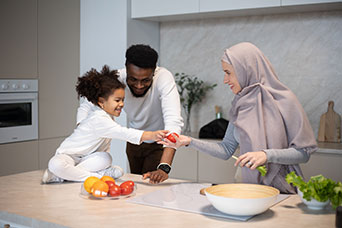Preschoolers are notorious for being picky eaters. It can be incredibly frustrating trying to encourage your child to eat healthy food items they refuse. It is important to remember that before we can realistically expect a child to consume a non-preferred food, they first must tolerate looking at it, touching it, smelling it, and tasting it. This requires your child to engage with the food prior to consuming it. The best way for children to engage with food is to play with it! Below are some ideas and tips to help increase your child’s engagement with commonly non-preferred foods. Disclosure: This could get messy!
- Broccoli
Make a broccoli forest!
Place broccoli stalks upright on your plate or table and create a delicious edible landscape. Bring in some of your children’s favorite toys like animals or dinosaurs and pretend that they are eating the leaves off the broccoli trees. Be a model for your child and say, “Uh oh, these trees are too tall! I need to trim the trees!” and take a few nibbles from the broccoli trees.
Incorporate a favorite dip or condiment.
Sometimes a yummy cheese dip is enough to entice a child into trying a less preferred food simply as a conduit for their preferred dip.
Use a long broccoli stalk as a paintbrush! Dip it into ranch dressing, ketchup, or hummus to make an abstract work of edible art on a plate, paper, or tortilla. Take it a step further and use your broccoli paintbrush as a lipstick or chapstick applicator. This is a great bridge from touching to tasting.
Brush your teeth!
Use a small stalk of broccoli as a pretend toothbrush and practice brushing your teeth! This is a fun and silly pretend play activity that helps your child orally explore a new or non-preferred food item.

- Brussels sprouts
Have a ball with Brussels sprouts!
Brussels sprouts are the perfect shape to practice some silly ball games while exploring a new and sometimes non-preferred food. Make a goal on your plate or kitchen table and practice finger kicking the sprout in. Make a ramp out of a plate and bowl and roll the sprout down a hill. Practice making a Brussels sprout snowman by stacking two or three on top of each other.
What’s at the center?
Take turns peeling off each of the sprout’s outer leaves to see how many it takes to get to the center. This is a great way to practice counting and size comparison as you discover the closer we get to the center, the smaller the leaves get. Encourage your child to taste one of the smaller inner leaves. Tasting a small part of a non-preferred food is less daunting than having to eat an entire Brussels sprout.

- Carrots
The leaning tower of carrots!
Prepare your carrots by cutting them into flat circular pieces. Encourage your child to stack them up and see how high she can make her carrot tower grow. Stack with her and make it a silly competition. This is another great opportunity to practice counting and descriptive terminology such as “short, tall, big, and little.”
Silly faces
Once your child is comfortable touching a carrot with her hands, a great next step is encouraging her to touch her carrot to her face or near her mouth. Use a carrot cut long ways, or a baby carrot, to make a silly mustache! Bring the carrots up to your eyebrows to practice making angry and surprised faces. Place a small portion of your carrot in your mouth to show a silly orange tongue. Anything that playfully encourages oral exploration of a non-preferred food is a great step towards tasting and consuming. This is also an excellent activity to do with our next food item, green beans!

- Green beans
What’s inside?
Practice opening up each of your green beans to find a hidden surprise: Beans! Take the opportunity to count how many beans each has inside. Compare and contrast using words like “more” and “less.” Whosever green bean has the most inside is the winner! Encourage your child to taste the bean inside. Do they taste different or the same?
Vegetable alphabet
Green beans are the perfect shape and size to practice alphabet skills. See if you and your child can create the ABCs with the vegetables on the plate. Practice spelling your child’s name. Be sure to sing the ABCs to encourage engagement and participation.
Many of these fun tips and ideas can be implemented with a variety of different foods. Remember to always present foods with a positive effect. You are your child’s best model, show them how much you enjoy these delicious and healthy foods!
Lastly, be patient! Studies show that children require approximately 12 different exposures to a new food before he or she will “like” it. This means touching, smelling, tasting, and playing with food 12 times before actually consuming it! Mealtime should be a joyful time where families have an opportunity to connect and grow healthy together. Enjoy it!
References:
Wardle, J., Cooke, L. J., Gibson, E., Sapochnik, M., Sheiham, A., & Lawson, M. (2003). Increasing childrens acceptance of vegetables; a randomized trial of parent-led exposure. Appetite, 40(2), 155–162. doi: 10.1016/s0195-6663(02)00135-6

Blue Bird Day fosters socialization, sensory regulation, and pre-academic learning in children ages 2-7 years in therapeutic rotations that simulate preschool and kindergarten settings. Our compassionate therapists practice a relationship-based and family-centered approach, provide parent training, and collaborate on goals and individualized intensive treatment plans for your child.
We believe in a collaborative and multi-disciplinary team approach to therapy. A team of occupational therapists, speech-language pathologists, dietitians, developmental therapists, behavioral therapists, physical therapists, and therapeutic assistants are created for each child to ensure child and family are fully supported and the best possible results are achieved.
Options for individualized, group and virtual therapy sessions are available as well.
Want to learn more or you have a specific question? Feel free to connect with us here!



